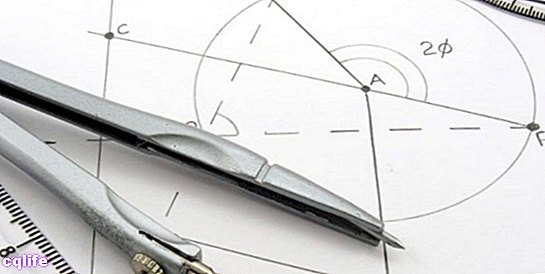We explain what geometry is, its history and its object of study. In addition, the characteristics of each type of geometry.

What is geometry?
Geometry (from the Greek geo, "Land", and meter, “Measurement”) is one of the oldest branches of the math, dedicated to the study of the shape of individual objects, the spatial relationship between them and the properties of the space that surrounds them.
Although in its beginnings this discipline obeyed, as its name indicates, the measurement in its most practical sense, over time the humanity he understood that even the most complex abstractions and representations can be expressed in geometric terms.
It was thus that its numerous branches arose, from the hand of mathematical analysis and other forms of calculation, especially those that link geometric representation with numerical and algebraic mathematical expressions.
Geometry is a fundamental branch of mathematics, on which numerous disciplines are based (such as the technical drawing or own architecture) and serves as a complement to many others (such as physical, the mechanics, the astronomy, etc.). In addition, it has given rise to numerous artifacts, from the compass and pantograph, to the global positioning system (GPS).
History of geometry
Geometry has its origins practically in the first human civilizations. The ancient Babylonians were the inventors of the wheel and therefore of the geometry of the circles. For this reason, they were probably the first to recognize the infinite potential of geometric study, which they soon applied to astronomy.
The ancient Egyptians did the same, who cultivated it enough to apply it in their majestic architectural works, since at that time geometry and arithmetic were Sciences eminently practical.
Many Greek historians, such as Herodotus (c. 484-c. 425 BC), Diodorus (c. 90 BC - c. 30 BC) and Strabo (c. 63 BC - c 24 AD) recognized the importance of the Egyptian geometric legacy, and were considered the creators of the discipline. However, it was the ancient Greeks who gave geometry its formal aspect, thanks to their advanced philosophical model.
Of particular importance was the mathematician and geometrist Euclides (c. 325 - c. 265 BC), recognized as the "father of geometry", who proposed the first geometric system for checking results, through his celebrated work The elements, composed about the year 300 a. C. in Alexandria. There the differences between the plane are enunciated for the first time (two-dimensional) and the space (three-dimensional).
Other important contributions to the geometry of the time were those of Archimedes (c. 287 - c. 212 BC) and Apollonius of Perge (c. 262 - c. 190 BC). However, in subsequent centuries the development of mathematics moved to the East (India, specifically, and the Muslim world), where geometry developed alongside algebra and the trigonometry, linking them with the astrology and astronomy.
Thus, interest in the discipline returned to the West only in the Renaissance European, in which many new names were added to his study, thus giving rise to projective geometry and especially Cartesian geometry or analytic geometry, fruit of the work of the French philosopher René Descartes (1596-1650), the bearer of a new geometric research method that revolutionized and modernized this field of knowledge.
From then on, modern geometry took place, by the hand of great scholars such as the German Carl Friedrich Gauss (1777-1855), the Russian Nikolái Lobachevski (1792-1856), the Hungarian János Bolyai (1802-1860), among many others, who managed to depart from the classical axioms of Euclid and found a new field of discipline: non-Euclidean geometry.
Object of study of geometry
Geometry operates in both the two-dimensional and the three-dimensional.Geometry deals with the properties of space and in particular with shapes and figures that inhabit it, either two-dimensional (plane) or three-dimensional (space), such as points, lines, planes, polygons, polyhedra, and so on. These types of objects are understood in terms of idealizations, that is, of mental projections of space, in order to transfer (or not) their conclusions to the world of the concrete.
Geometry types
Geometry has many different branches, and its classification generally responds to the relationship it establishes with the five basic postulates of Euclid, of which only four have been widely demonstrated since antiquity. The fifth, on the other hand, had to be modified to give rise to different families of geometries.
Thus, we must distinguish between:
Absolute geometry, one that is governed by the first four postulates of Euclid.
Euclidean geometry, one that also accepts the fifth Euclidean postulate as an axiom, in turn giving rise to two variants: the geometry of the plane (two-dimensional) and the geometry of space (three-dimensional), according to the ancient Greek classification.
Classical geometry, one in which the results of Euclidean geometries are compiled.
Non-Euclidean geometry, which emerged in the 19th century, is one that brings together the different geometric systems that are far from the fifth postulate of Euclid, accepting, however, the first four or some of them. Among them are:
- Elliptical or Riemannian geometry, which obeys the first four postulates of Euclid and presents a model of constant and positive curvature.
- Hyperbolic or lobachevskian geometry, which obeys only the first four postulates of Euclid and presents a model of constant and negative curvature.
- Spherical geometry, understood as the geometry of the two-dimensional surface of a sphere (rather than a straight plane), is a simpler model of elliptical geometry.
- Finite geometry, whose system obeys a limited number of points (unlike the infinite geometry of Euclid), and whose models apply only in a finite plane. There are two types of finite geometries: affine and projective.
